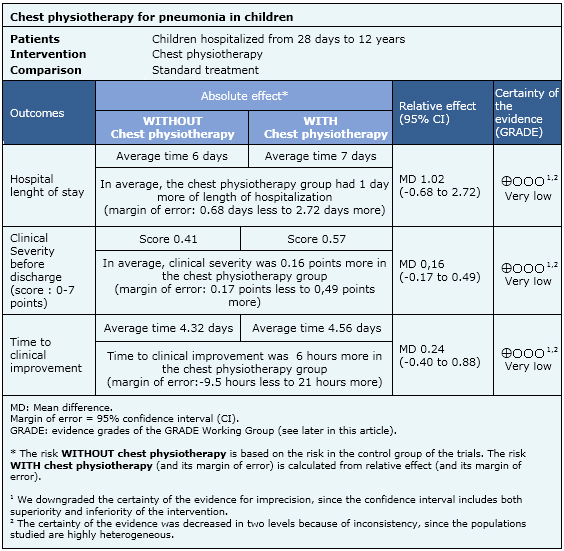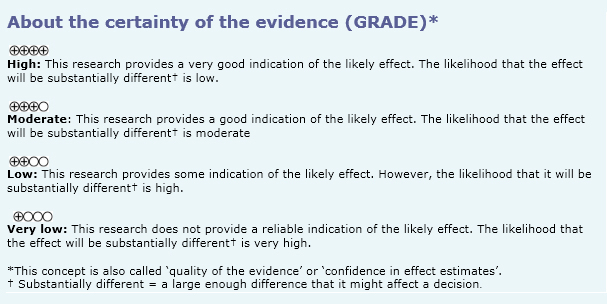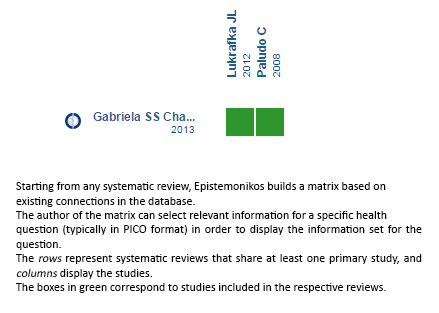 Para Descargar PDF debe Abrir sesión.
Para Descargar PDF debe Abrir sesión.
Chest physiotherapy is applied in clinical practice for the treatment of pneumonia. However, its use is still controversial. Searching in Epistemonikos database, which is maintained by screening 30 databases, we identified one systematic review including two relevant randomized controlled trials. We combined the evidence using meta-analysis and generated a summary of findings table following the GRADE approach. We concluded it is unclear whether chest physiotherapy increases or decreases the length of hospitalization, severity, or the time to clinical improvement in children with pneumonia because the certainty of the evidence is very low.
Pneumonia is an acute inflammatory lung disease, affecting people at different ages worldwide. However, the most severe consequences and morbidity are related to young children and elderly subjects. Chest physiotherapy has been widely used for pediatric patients. The main goal of this therapy is to assist the clearance of bronchial secretions, maintain lung capacities and to improve clinical outcomes reducing airway resistance and work of breathing.
We used Epistemonikos database, which is maintained by screening more than 30 databases, to identify systematic reviews and their included primary studies. With this information, we generated a structured summary using a pre-established format, which includes key messages, a summary of the body of evidence (presented as an evidence matrix in Epistemonikos), meta-analysis of the total of studies, a summary of findings table following the GRADE approach and a table of other considerations for decision-making.
|
Key messages
|
|
What is the evidence. |
We found only one systematic review [1] including two pertinent randomized controlled trials [2],[3]. |
|
What types of patients were included |
The studies included hospitalized patients with pneumonia that were clinically stable for receiving chest physiotherapy. Both baseline risk and pneumonia severity of patients were variable. Age ranged from 29 days to 12 years. |
|
What types of interventions were included |
Different types of chest physiotherapy were used. The first study applied standardized chest physiotherapy including positioning, thoracic vibration, thoracic compression, positive expiratory pressure, breathing exercises and forced exhalation with the glottis open or ’huffing’ [2]. The other study made postural drainage, thoracic squeezing, chest percussion, vibration, cough stimulation and secretions suctioning (if necessary)[3]. Frequency and duration of chest physiotherapy were variable. In the first study patients received it three times daily [2] and in the other study patients received it twice daily for 30 minutes each session [3]. All studies were compared with standard treatment (oxygen administration, antibiotics and fluids if necessary). |
|
What types of outcomes |
Time to clinical resolution, hospital length of stay, arterial oxygen saturation, X-ray, lung auscultation, and cough duration. |
The information on the effects of chest physiotherapy is based on two randomized trials including 177 patients. Both studies included hospital length of stay as an outcome. One study measured clinical severity [2] and one study considered time to clinical improvement [3].


|
To whom this evidence does and does not apply |
|
| About the outcomes included in this summary |
|
| Balance between benefits and risks, and certainty of the evidence |
|
| What would patients and their doctors think about this intervention |
|
| Resource considerations |
|
| Feasibility and implementation |
|
|
Differences between this summary and other sources |
|
| Could this evidence change in the future? |
|
Using automated and collaborative means, we compiled all the relevant evidence for the question of interest and we present it as a matrix of evidence.

Follow the link to access the interactive version: Chest physiotheraphy in hospitalized children with pneumonia
The upper portion of the matrix of evidence will display a warning of “new evidence” if new systematic reviews are published after the publication of this summary. Even though the project considers the periodical update of these summaries, users are invited to comment in Medwave or to contact the authors through email if they find new evidence and the summary should be updated earlier. After creating an account in Epistemonikos, users will be able to save the matrixes and to receive automated notifications any time new evidence potentially relevant for the question appears.
The details about the methods used to produce these summaries are described here http://dx.doi.org/10.5867/medwave.2014.06.5997.
Epistemonikos foundation is a non-for-profit organization aiming to bring information closer to health decision-makers with technology. Its main development is Epistemonikos database (www.epistemonikos.org).
These summaries follow a rigorous process of internal peer review.
Conflicts of interest
The authors do not have relevant interests to declare.
 Esta obra de Medwave está bajo una licencia Creative Commons Atribución-NoComercial 3.0 Unported. Esta licencia permite el uso, distribución y reproducción del artículo en cualquier medio, siempre y cuando se otorgue el crédito correspondiente al autor del artículo y al medio en que se publica, en este caso, Medwave.
Esta obra de Medwave está bajo una licencia Creative Commons Atribución-NoComercial 3.0 Unported. Esta licencia permite el uso, distribución y reproducción del artículo en cualquier medio, siempre y cuando se otorgue el crédito correspondiente al autor del artículo y al medio en que se publica, en este caso, Medwave.

Chest physiotherapy is applied in clinical practice for the treatment of pneumonia. However, its use is still controversial. Searching in Epistemonikos database, which is maintained by screening 30 databases, we identified one systematic review including two relevant randomized controlled trials. We combined the evidence using meta-analysis and generated a summary of findings table following the GRADE approach. We concluded it is unclear whether chest physiotherapy increases or decreases the length of hospitalization, severity, or the time to clinical improvement in children with pneumonia because the certainty of the evidence is very low.
 Autores:
Felipe Damiani[1,2], Rodrigo Adasme [2,3]
Autores:
Felipe Damiani[1,2], Rodrigo Adasme [2,3]

Citación: Damiani F, Adasme R. What is the effect of chest physiotherapy in hospitalized children with pneumonia?. Medwave 2015;15(Suppl 2):e6287 doi: 10.5867/medwave.2015.6287
Fecha de publicación: 19/10/2015

Nos complace que usted tenga interés en comentar uno de nuestros artículos. Su comentario será publicado inmediatamente. No obstante, Medwave se reserva el derecho a eliminarlo posteriormente si la dirección editorial considera que su comentario es: ofensivo en algún sentido, irrelevante, trivial, contiene errores de lenguaje, contiene arengas políticas, obedece a fines comerciales, contiene datos de alguna persona en particular, o sugiere cambios en el manejo de pacientes que no hayan sido publicados previamente en alguna revista con revisión por pares.
Aún no hay comentarios en este artículo.
Para comentar debe iniciar sesión
 Medwave publica las vistas HTML y descargas PDF por artículo, junto con otras métricas de redes sociales.
Medwave publica las vistas HTML y descargas PDF por artículo, junto con otras métricas de redes sociales.
 Chaves GS, Fregonezi GA, Dias FA, Ribeiro CT, Guerra RO, Freitas DA, Pet al. Chest physiotherapy for pneumonia in children. Cochrane Database Syst Rev. 2013 Sep 20;9:CD010277. | CrossRef | PubMed |
Chaves GS, Fregonezi GA, Dias FA, Ribeiro CT, Guerra RO, Freitas DA, Pet al. Chest physiotherapy for pneumonia in children. Cochrane Database Syst Rev. 2013 Sep 20;9:CD010277. | CrossRef | PubMed | Lukrafka JL, Fuchs SC, Fischer GB, Flores JA, Fachel JM, Castro-Rodriguez JA. Chest physiotherapy in paediatric patients hospitalised with community-acquired pneumonia: a randomised clinical trial. Arch Dis Child. 2012 Nov;97(11):967-71. | CrossRef | PubMed |
Lukrafka JL, Fuchs SC, Fischer GB, Flores JA, Fachel JM, Castro-Rodriguez JA. Chest physiotherapy in paediatric patients hospitalised with community-acquired pneumonia: a randomised clinical trial. Arch Dis Child. 2012 Nov;97(11):967-71. | CrossRef | PubMed | Paludo C, Zhang L, Lincho CS, Lemos DV, Real GG, Bergamin JA. Chest physical therapy for children hospitalised with acute pneumonia: a randomised controlled trial. Thorax. 2008 Sep;63(9):791-4. | CrossRef | PubMed |
Paludo C, Zhang L, Lincho CS, Lemos DV, Real GG, Bergamin JA. Chest physical therapy for children hospitalised with acute pneumonia: a randomised controlled trial. Thorax. 2008 Sep;63(9):791-4. | CrossRef | PubMed | Bradley JS, Byington CL, Shah SS, Alverson B, Carter ER, Harrison C, et al. The management of community-acquired pneumonia in infants and children older than 3 months of age: clinical practice guidelines by the Pediatric Infectious Diseases Society and the Infectious Diseases Society of America. Clin Infect Dis. 2011 Oct;53(7):e25-76. | CrossRef | PubMed |
Bradley JS, Byington CL, Shah SS, Alverson B, Carter ER, Harrison C, et al. The management of community-acquired pneumonia in infants and children older than 3 months of age: clinical practice guidelines by the Pediatric Infectious Diseases Society and the Infectious Diseases Society of America. Clin Infect Dis. 2011 Oct;53(7):e25-76. | CrossRef | PubMed | Harris M, Clark J, Coote N, Fletcher P, Harnden A, McKean M, et al. British Thoracic Society guidelines for the management of community acquired pneumonia in children: update 2011. Thorax. 2011 Oct;66 Suppl 2:ii1-23. | CrossRef | PubMed |
Harris M, Clark J, Coote N, Fletcher P, Harnden A, McKean M, et al. British Thoracic Society guidelines for the management of community acquired pneumonia in children: update 2011. Thorax. 2011 Oct;66 Suppl 2:ii1-23. | CrossRef | PubMed | Luna CM, Monteverde A, Rodríguez A, Apezteguia C, Zabert G, Ilutovich S, et al. [Clinical guidelines for the treatment of nosocomial pneumonia in Latin America: an interdisciplinary consensus document. Recommendations of the Latin American Thoracic Society]. Arch Bronconeumol. 2005
Aug;41(8):439-56. | PubMed |
Luna CM, Monteverde A, Rodríguez A, Apezteguia C, Zabert G, Ilutovich S, et al. [Clinical guidelines for the treatment of nosocomial pneumonia in Latin America: an interdisciplinary consensus document. Recommendations of the Latin American Thoracic Society]. Arch Bronconeumol. 2005
Aug;41(8):439-56. | PubMed | Gobierno de Chile, Ministerio de Salud. Guía Clínica infección respiratoria aguda baja de manejo ambulatorio en menores de 5 años. Santiago, Chile: MINSAL; 2013. | Link |
Gobierno de Chile, Ministerio de Salud. Guía Clínica infección respiratoria aguda baja de manejo ambulatorio en menores de 5 años. Santiago, Chile: MINSAL; 2013. | Link | Morrow B. The use of chest physiotherapy in children hospitalised with pneumonia. Pan African Clinical Trials Registry PACTR201404000706382. 2013. [on line] | Link |
Morrow B. The use of chest physiotherapy in children hospitalised with pneumonia. Pan African Clinical Trials Registry PACTR201404000706382. 2013. [on line] | Link |